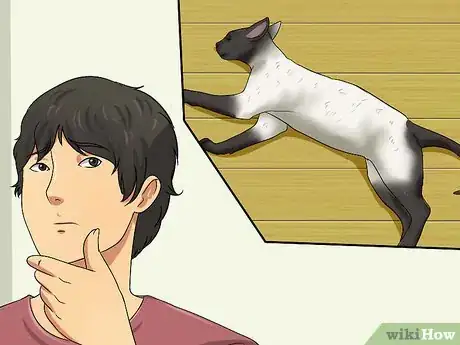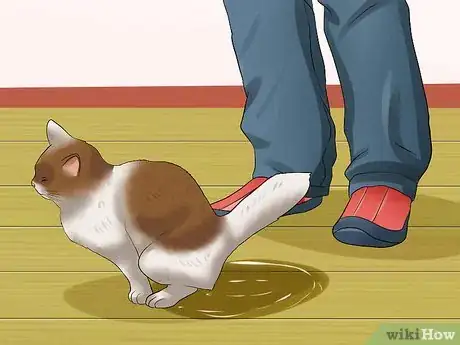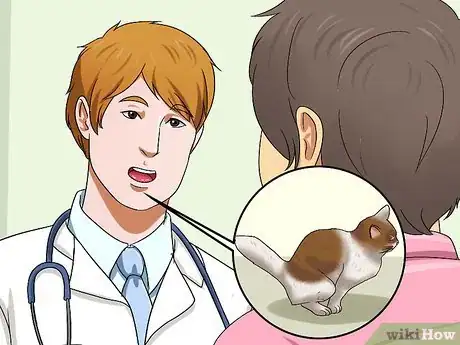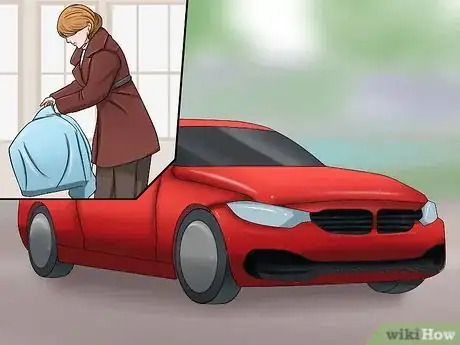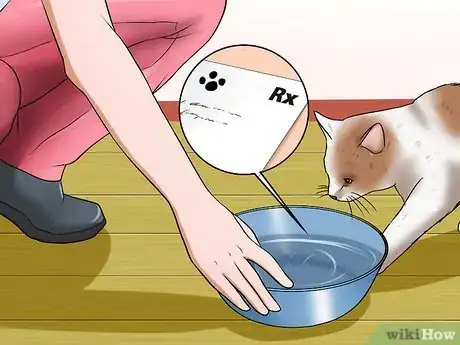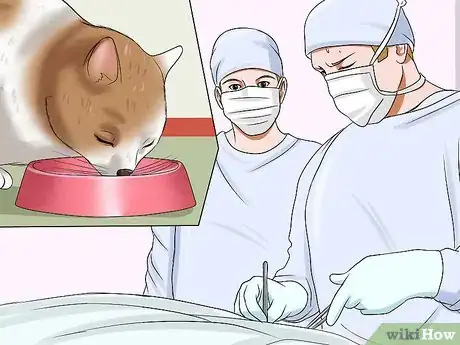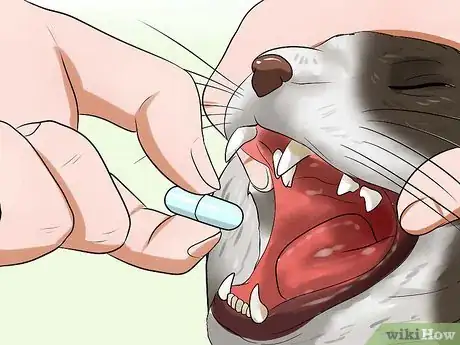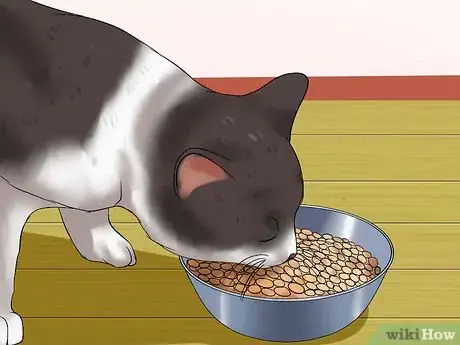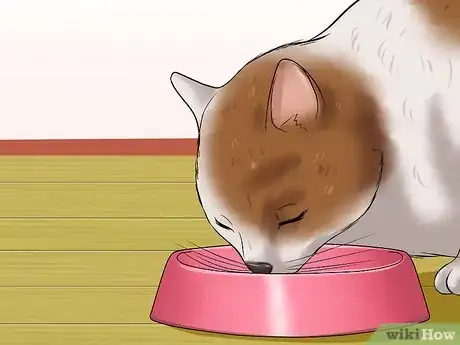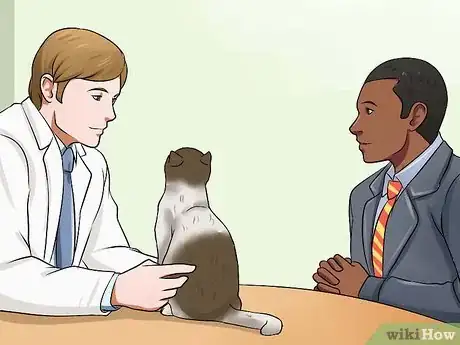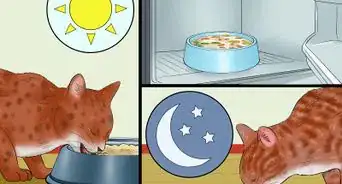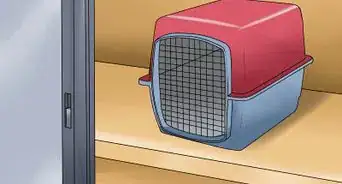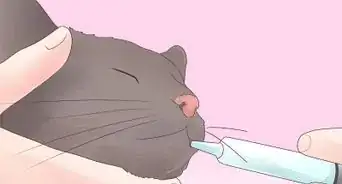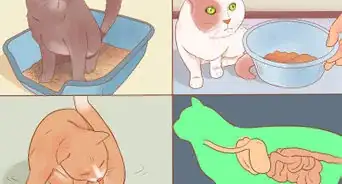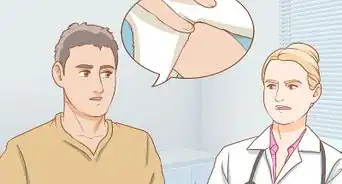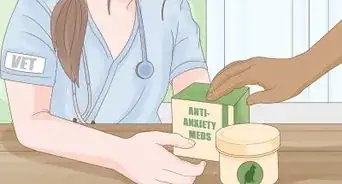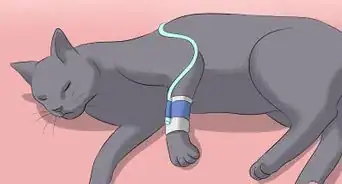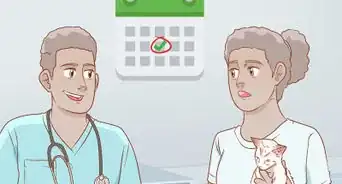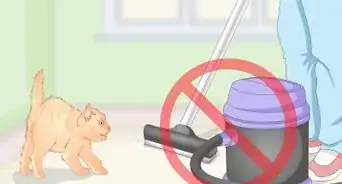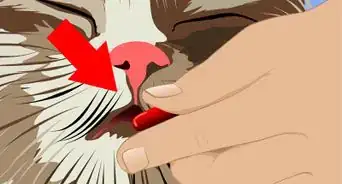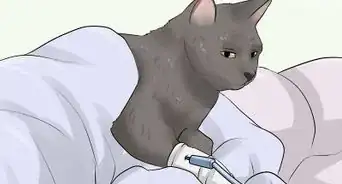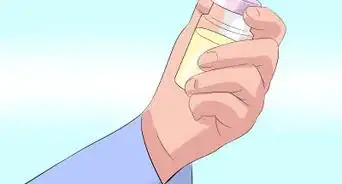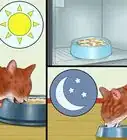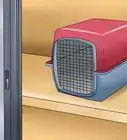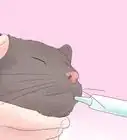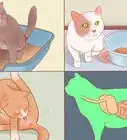This article was co-authored by Pippa Elliott, MRCVS. Dr. Elliott, BVMS, MRCVS is a veterinarian with over 30 years of experience in veterinary surgery and companion animal practice. She graduated from the University of Glasgow in 1987 with a degree in veterinary medicine and surgery. She has worked at the same animal clinic in her hometown for over 20 years.
There are 10 references cited in this article, which can be found at the bottom of the page.
wikiHow marks an article as reader-approved once it receives enough positive feedback. In this case, 93% of readers who voted found the article helpful, earning it our reader-approved status.
This article has been viewed 223,771 times.
Uroliths, commonly referred to as bladder stones, are small mineral concentrations that build up in the urinary tract of animals. Cats of any breed and age may be affected by bladder stones, which come in a variety of shapes and sizes. If left untreated, the stones may irritate the urinary tract, causing bleeding, and can also block the flow of urine, leading to irreversible kidney damage and death. Learning the signs and symptoms of bladder stones is crucial to help with early detection and treatment in your cat.
Steps
Diagnosing Bladder Stones in Cats
-
1Know your cat's risk. Certain cat breeds, such as Himalayans, have a genetic predisposition toward developing mineral deposits in the bladder.[1] But other factors can cause bladder stones in any breed.
- A diet high in acidity or calcium, magnesium, or phosphorus may cause mineral buildup.[2]
- Decreased water consumption may lead to the concentration of minerals in the bladder.[3]
- A urinary tract infection may lead to bladder stones.[4]
- Certain medications and supplements, including Lasix, Cortisone, Ascorbic Acid, Tetracycline, and Sulfa drugs, may cause bladder stones when used over prolonged periods of time if the cat has a genetic tendency to do so.[5]
-
2Check for symptoms. It is important to be alert for signs that your cat may have uroliths. Common signs to look for include:Advertisement
-
3Consult with your veterinarian. Your vet will be able to diagnose bladder stones, and may be able to determine how severe the blockage is in your cat.
- Report any unusual behavior or problems you've noticed in your cat.
- Your vet may take an X Ray or conduct other tests, such as palpating your cat's abdomen, checking its urine, or taking an ultrasonography test.
- If the cat has bladder stones, a stone, or group of stones, will be seen in the urinary bladder, or other parts of the urinary system such as the kidney, ureter, or urethra.[10]
Treating Bladder Stones
-
1Act fast. If your cat is suffering from bladder stones, time may be of the essence. Stones have been shown to grow to problematic sizes in as little as two weeks.[11] Bladder stone growth may lead to severe pain, vomiting, and depression.[12]
- If a blocked ureter is not diagnosed and treated quickly, the blocked kidney may become irreversibly damaged.[13]
-
2Consider your options. Depending on the severity and location of your cat's bladder stones, your veterinarian may recommend something as simple as a change in diet, or a major surgical procedure.
- Your vet may prescribe a special diet that will dissolve mineral deposits in your cat and alter its pH to prevent future deposits.[14]
- Your vet may flush your cat's bladder. This involves the use of a catheter to remove deposits and any residual sediment.
- Your vet may perform a cystostomy, in which the bladder is surgically opened and the mineral deposits physically removed.
- Your vet may recommend a perineal urethrotomy, in which the urethra is surgically widened.
-
3Prepare your cat for surgery. If your veterinarian recommends surgery as the best option to remove a severe bladder stone, there are several steps you may need to take to prepare it for surgery.
- Have your cat fast before receiving anesthesia. Any time an animal is anesthetized, there is a risk that, if vomiting occurs, it may be inhaled into the lungs. The best way to prevent this is to keep your pet from eating any food prior to the scheduled procedure. Fast times may vary, depending on your cat's age and size, and the specific anesthesia being used on your cat. Consult with your veterinarian to determine how long your cat should fast prior to surgery.[15]
- Keep your cat hydrated. Unless your vet advises otherwise, you should be able to give your cat water overnight until the morning of the procedure.[16]
- If your cat requires daily medication, ask your veterinarian whether or not to administer those medications prior to surgery.
-
4Provide post-surgical care. If your cat has undergone surgery, your vet will provide you with the information you need to care for your cat after its surgery. This will probably include giving your cat medication regularly, and may call for more frequent veterinary check-ups.
- Your vet may want to send the stones away for analysis in a laboratory. Knowing the precise mineral content of the stones can make it easier to determine the appropriate prevention methods, including prescription medication to prevent the formation of future bladder stones.[17]
Preventing Future Bladder Stones
-
1Change your cat's diet. While animal experts are not completely certain why bladder stones form, they have noticed an increase in one particular type of stone, calcium oxalate, in recent years.[18] There are many different types of mineral stones. The type depends on the minerals from which they are formed. Your veterinarian will send the stone away for analysis and from that recommend a diet low in the minerals from which your cat's stone was built.
- Choose the diet appropriate for your cat's urolith type. For example, for oxalate stones try a non-acidifying diet diet with low- to moderate-levels of calcium, as well as magnesium and citrate components. This type of diet can help reduce urinary calcium and may prevent buildup of calcium oxalate.
- Use canned food instead of dry food. The extra water content found in canned cat food may help dilute urine and prevent the buildup of minerals.[19]
-
2Give your cat plenty of fresh water. Cats generally prefer fresh water, and may not drink water that has been out for several days.
- Empty and refill your cat's water bowl every day. This will also help you monitor how much water your cat is drinking.
-
3Go for regularly-scheduled follow-up visits. Your veterinarian may recommend that you bring your cat back for urinalysis and urine cultures periodically in the months that follow a bladder stone procedure.[20] Keeping regular vet appointments can help ensure that your cat has a full recovery and does not have a repeat incidence.
Expert Q&A
-
QuestionWhat food should a cat with bladder stones eat?
 Pippa Elliott, MRCVSDr. Elliott, BVMS, MRCVS is a veterinarian with over 30 years of experience in veterinary surgery and companion animal practice. She graduated from the University of Glasgow in 1987 with a degree in veterinary medicine and surgery. She has worked at the same animal clinic in her hometown for over 20 years.
Pippa Elliott, MRCVSDr. Elliott, BVMS, MRCVS is a veterinarian with over 30 years of experience in veterinary surgery and companion animal practice. She graduated from the University of Glasgow in 1987 with a degree in veterinary medicine and surgery. She has worked at the same animal clinic in her hometown for over 20 years.
Veterinarian This is a simple question which has a complicated answer. The diet depends on what type of stone or crystals are present, and the pH of the urine. For example a good diet for getting rid of struvite crystals, might accidentally encourage the growth of oxalate. The single most important thing you can do is encourage the cat to drink plenty of water and feed them wet food. Then whatever crystals are present in the urine are more likely to be washed out regularly when the cat passes water.
This is a simple question which has a complicated answer. The diet depends on what type of stone or crystals are present, and the pH of the urine. For example a good diet for getting rid of struvite crystals, might accidentally encourage the growth of oxalate. The single most important thing you can do is encourage the cat to drink plenty of water and feed them wet food. Then whatever crystals are present in the urine are more likely to be washed out regularly when the cat passes water. -
QuestionIs it possible for a cat to have different stones at the same time, like calcium oxalate and struvite?
 Pippa Elliott, MRCVSDr. Elliott, BVMS, MRCVS is a veterinarian with over 30 years of experience in veterinary surgery and companion animal practice. She graduated from the University of Glasgow in 1987 with a degree in veterinary medicine and surgery. She has worked at the same animal clinic in her hometown for over 20 years.
Pippa Elliott, MRCVSDr. Elliott, BVMS, MRCVS is a veterinarian with over 30 years of experience in veterinary surgery and companion animal practice. She graduated from the University of Glasgow in 1987 with a degree in veterinary medicine and surgery. She has worked at the same animal clinic in her hometown for over 20 years.
Veterinarian Struvite and oxalate stones need the opposite pH to develop, so a mixed population of mature stones is unlikely. However, 'mixed' stones are not uncommon where the center of the stone has one composition (such as oxalate) with a layer of struvite is deposited on the outside. This is possible because the urine pH originally favored oxalate stone formation, the stone rubbed the bladder which caused an infection, the bacteria causing the infection shifted the pH of the urine, which then allowed struvite to be deposited on top of the oxalate.
Struvite and oxalate stones need the opposite pH to develop, so a mixed population of mature stones is unlikely. However, 'mixed' stones are not uncommon where the center of the stone has one composition (such as oxalate) with a layer of struvite is deposited on the outside. This is possible because the urine pH originally favored oxalate stone formation, the stone rubbed the bladder which caused an infection, the bacteria causing the infection shifted the pH of the urine, which then allowed struvite to be deposited on top of the oxalate.
Warnings
- Always take your cat to the vet right away if you suspect any health issues.⧼thumbs_response⧽
- If urine cannot pass freely out of your cat's body, its abdomen will get very painful. Your pet could cry and wince in pain as it urinates. Slight pressure applied to the cat's abdominal could produce violent reactions from your cat due to the tremendous pain it is experiencing. Exercise caution, and try not to pick up your cat, taking special care of its abdominal area.⧼thumbs_response⧽
Things You'll Need
- Carrier for vet visits
- Appropriate food as recommended by the vet
- Medications as prescribed by the vet
- Water
References
- ↑ http://www.uvma.org/cats/urinary-problems.htm
- ↑ http://www.lbah.com/word/bladder-stones/
- ↑ https://www.aspca.org/pet-care/cat-care/bladder-stones
- ↑ https://www.aspca.org/pet-care/cat-care/bladder-stones
- ↑ http://www.lbah.com/word/bladder-stones/
- ↑ http://www.vcahospitals.com/main/pet-health-information/article/animal-health/bladder-stones-in-cats/57
- ↑ http://www.vcahospitals.com/main/pet-health-information/article/animal-health/bladder-stones-in-cats/57
- ↑ http://www.peteducation.com/article.cfm?c=1+2142&aid=2729
- ↑ http://www.peteducation.com/article.cfm?c=1+2142&aid=2729
- ↑ The Merck/Merial Manual for Pet Health, Urinary Stones (Uroliths, Calcili)', p. 524, (2007), ISBN 978-0-911910-99-5
- ↑ The Merck/Merial Manual for Pet Health, Urinary Stones (Uroliths, Calcili), p. 525, (2007), ISBN 978-0-911910-99-5
- ↑ The Merck/Merial Manual for Pet Health, Urinary Stones (Uroliths, Calcili), p. 524, (2007), ISBN 978-0-911910-99-5
- ↑ The Merck/Merial Manual for Pet Health, Urinary Stones (Uroliths, Calcili), p. 525, (2007), ISBN 978-0-911910-99-5
- ↑ https://www.aspca.org/pet-care/cat-care/bladder-stones
- ↑ http://www.pethealthnetwork.com/dog-health/dog-surgery-a-z/how-do-i-prepare-my-dog-or-cat-having-surgery
- ↑ http://www.pethealthnetwork.com/dog-health/dog-surgery-a-z/how-do-i-prepare-my-dog-or-cat-having-surgery
- ↑ The Merck/Merial Manual for Pet Health, Urinary Stones (Uroliths, Calcili), p. 524, (2007), ISBN 978-0-911910-99-5
- ↑ The Merck/Merial Manual for Pet Health, Urinary Stones (Uroliths, Calcili), p. 524, (2007), ISBN 978-0-911910-99-5
- ↑ http://feline-nutrition.org/health/crystals-raw-diets-and-water
- ↑ https://www.aspca.org/pet-care/cat-care/bladder-stones
